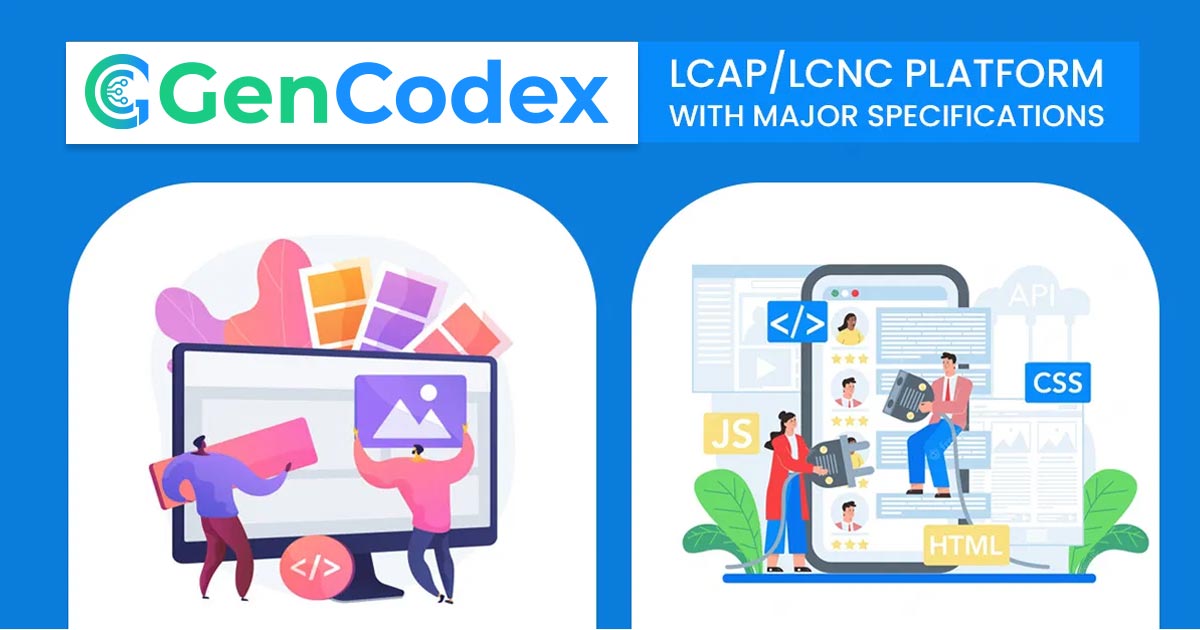GenCodex AI-Based: LCAP/LCNC Platform with Key Features

The software development industry has been transformed by low-code and no-code platforms, which allow developers to develop complex apps with less coding. GenCodex's low-code/no-code platform is one of the platforms that has been acknowledged among developers in recent years.
The low-code application platform (LCAP) is a software development environment enabling minimal hand-coding of applications. Low-code platforms aim to simplify and accelerate application development by abstracting away complex coding tasks. This allows users with limited programming skills to create functional applications.
The article describes the GenCodex platform, its working, and the related advantages that it provides to developers and businesses.
What does the term GenCodex identify?
GenCodex is a low-code, no-code platform that allows enterprises to create enterprise-grade apps without considerable coding. It is a cloud-based platform that allows you to construct apps using a drag-and-drop interface and supports a variety of programming languages, including Python, Java, and C#. GenCodex is made for simple use, especially for individuals without significant technical knowledge.
What is the working process of GenCodex?
GenCodex works by offering a collection of pre-built components that may be utilised to rapidly and efficiently develop applications. User interface elements, data connections, and processes are examples of these components. Developers may easily link these components to create a functional application by dragging and dropping them into a canvas.
GenCodex also allows custom code, which implies that developers may add their code to increase the platform's capabilities. This enables developers to create complicated apps capable of integrating with other systems and services.
Major Specifications of the GenCodex LCNC/LCAP platform
1. Real-time visibility
The technology provides organizations with real-time access to the supply chain, allowing them to track shipments, track inventory levels, and get notifications if any concerns develop. This functionality can assist companies in making knowledgeable decisions regarding their supply chain operations, resulting in increased efficiency and lower costs.
2. Collaboration
Among all the stakeholders in the supply chain, the platform facilitates cooperation, including suppliers, manufacturers, distributors, and retailers. This tool can assist firms in more appropriate collaboration of working, sharing details and resources, and enhancing communication.
3. Generative AI-Powered Automation
Numerous supply chain operations, including order administration, inventory surveillance, and shipment tracking, are meant to be automated by the platform. Businesses may see considerable cost savings as a result of automation's ability to eliminate mistakes and increase productivity.
Generative AI low-code and no-code development is changing the way software is created and how IT teams work. These technologies help make processes quicker, more efficient, and encourage teamwork, allowing IT leaders to be more innovative while making the best use of their resources. For businesses that want to stay ahead of the competition, using low-code AI isn't just a helpful option—it's becoming essential.
4. Customizable Dashboards
The platform provides customizable dashboards that may be customized to meet the requirements of various users. For instance, a logistics coordinator may want to monitor the progress of shipments, but a supply chain manager may want to view real-time data on inventory levels. The configurable dashboards may give each user the information they require to execute their work well.
5. Integration
To give a full perspective of the supply chain, the platform may be connected with other systems such as ERP and CRM systems. Businesses may benefit from this integration by making better decisions, improving communication, and streamlining operations.
6. Analytics
The platform has comprehensive analytics capabilities that may assist firms in identifying patterns, analysing data, and making sound decisions. These analytics solutions may give useful supply chain information, such as determining areas for rectification and optimising inventory levels.
7. Mobile Access
The platform can be accessed via mobile devices, which may be a useful feature for companies with remote workers or staff who need to use it while they are not in the office.
Why Is GenCodex the Reasonable Alternative for LCAP Users?
Web Design and Development
Typically, the most popular programming languages like PHP, ASP.NET, Angular, etc. are used widely to build websites and e-commerce platforms. Popular content management systems (CMS) with little coding include WordPress, Magento, Joomla, Drupal, etc. Websites may be created without using any code. You can build a desired website and its design simply by just dragging and dropping the pre-made templates created by experts.
Application Development for Desktops and Online
The three most operated platforms are Desktop, smartphone, and cloud. The three main desktop operating systems are Windows, Linux, and Mac. There are also two modes of operation online and offline. Desktop software, particularly for Windows, is typically created in VB.NET, Java, etc.; for Linux, it is created in Java (Swing), C, C++, etc.; and for Apple Macs, it is created in Swift, Java (Swing), etc. Online programs, commonly referred to as SaaS (software as a service), are typically created using programming languages like Java (Spring), ASP.NET, Python, etc.
Application For Mobile Devices
There are two main operating platforms: Android and ios. Android apps are developed in Java, while ios apps are created using Swift. Additionally, hybrid application development utilizes frameworks such as React, Flutter, and Kotlin.
With the GenCodex AI-based low-code/no-code development platform, we can create apps and software for all platforms and operating systems, as these are developed using Java, Spring, Hibernate, and Angular.
Conclusion:
The GenCodex LCAP/LCNC Platform is a valuable tool for enterprises wishing to rapidly and effectively create enterprise-grade apps. Its drag-and-drop interface and support for a variety of programming languages make it a versatile platform for developing a wide range of apps. GenCodex is a platform that should be considered by enterprises of all sizes due to its capacity to cut development costs, boost productivity, and reduce time-to-market.



